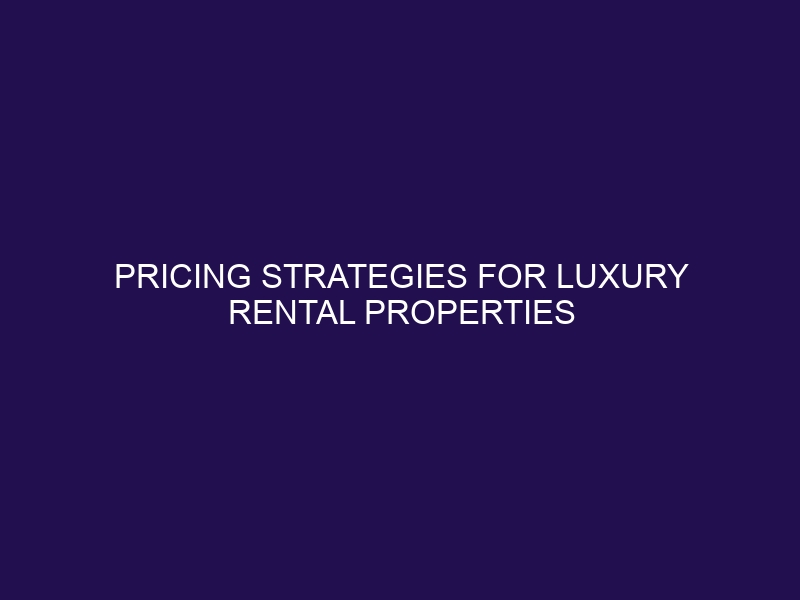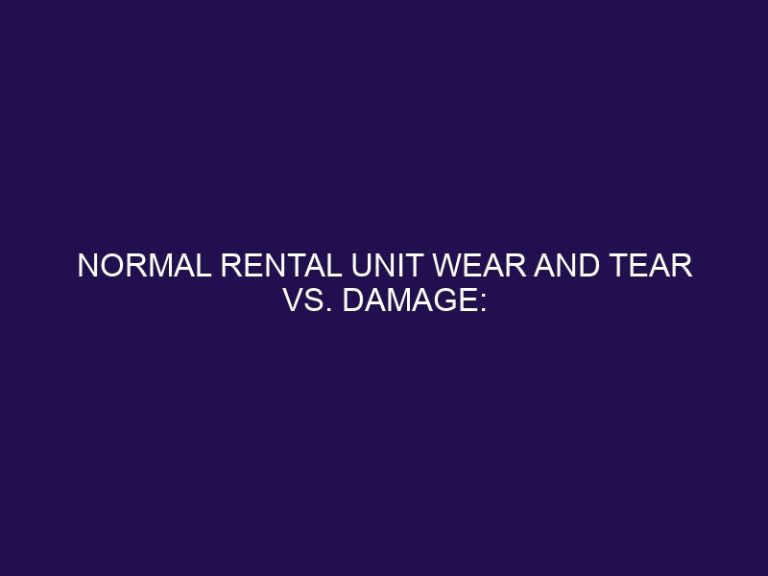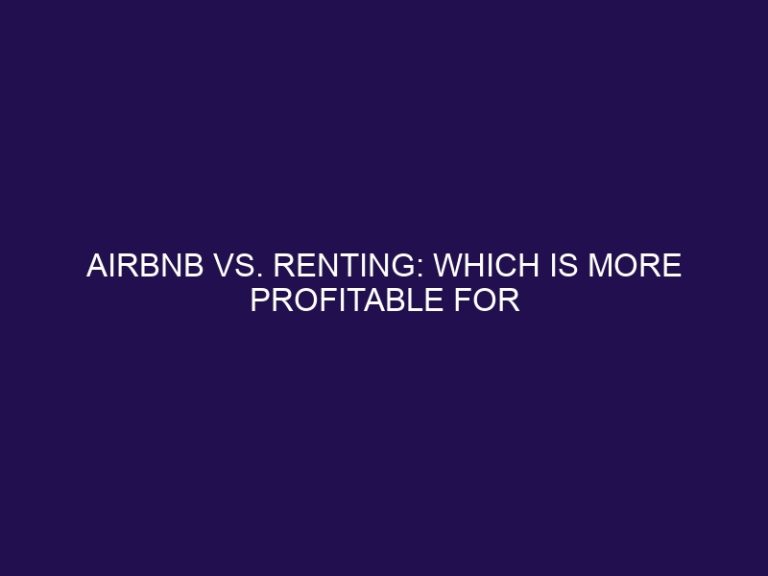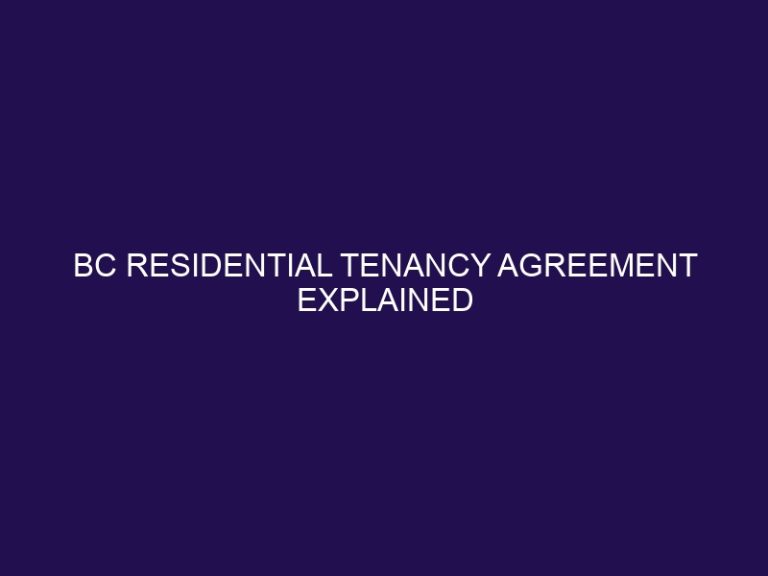Pricing Strategies for Luxury Rental Properties
Luxury rental properties are high-end properties that offer luxurious amenities and features to their residents. These properties cater to a niche market of affluent individuals who are willing to pay a premium for an exclusive living experience. However, setting the right rental price for these properties can be a challenging task for property owners and managers.
Pricing is crucial for luxury rental properties as it not only determines the rental income but also affects the overall perception and demand for the property. In this article, we will discuss the various factors that influence pricing for luxury rental properties, different pricing strategies, and best practices for implementing them.
When setting rental prices for luxury properties, some of the key factors to consider are:
- Location
- Property features and amenities
- Market demand
- Competition
- Target audience
The location of the property plays a significant role in determining its value and rental price. Properties in prime locations or with desirable views can command higher prices. The features and amenities offered by the property, such as a gym, swimming pool, or concierge services, also impact the rental price. Market demand for luxury properties in a particular area and the level of competition from other similar properties can also affect pricing. Additionally, understanding the target audience and their preferences can help in setting the right rental price.
There are three main pricing strategies that can be used for luxury rental properties:
- Market-oriented pricing
- Cost-oriented pricing
- Value-based pricing
Market-oriented pricing involves setting prices based on the current market conditions and the price of similar properties in the area. Cost-oriented pricing is based on the expenses incurred in operating and maintaining the property, including rent, taxes, and utilities. Value-based pricing considers the perceived value of the property and the lifestyle it offers to its residents.
Implementing these pricing strategies requires careful consideration and best practices. It is essential to conduct market research to understand the current market conditions and the demand for luxury properties in the area. Setting competitive prices that are in line with similar properties in the market can also help attract potential tenants. Offering incentives and discounts, such as free rent for the first month, can entice potential tenants and create a sense of urgency. Considering seasonal pricing, where rental prices may be higher during peak seasons, can also help maximize rental income. Regularly monitoring and adjusting prices based on market conditions and demand is crucial for maintaining a competitive edge in the luxury rental market.
In conclusion, finding the right pricing strategy for luxury rental properties requires a thorough understanding of market conditions, competition, and the target audience. By considering all these factors and implementing best practices, property owners and managers can set the right rental prices to attract and retain high-end tenants, ultimately maximizing their return on investment.
Why is Pricing Important for Luxury Rental Properties?
Pricing is essential for luxury rentals as it not only reflects exclusivity but also maintains market appeal and optimizes revenue. Proper pricing is crucial for ensuring profitability and attracting high-end tenants, ultimately elevating property value and enhancing overall brand reputation.
Factors to Consider when Setting Rental Prices for Luxury Properties
When setting rental prices for luxury properties, there are several important factors to take into consideration. These factors can greatly impact the success and profitability of a luxury rental property. In this section, we will discuss the key elements that should be considered when determining the pricing strategy for a luxury rental property. From the location and features of the property to market demand and competition, each factor plays a crucial role in setting the right rental price. Additionally, we will also explore the importance of understanding and targeting the right audience for a luxury rental property.
1. Location
- Research prime locations for luxury rentals, focusing on affluent neighborhoods or scenic areas.
- Consider the location’s proximity to amenities, attractions, and transportation for added desirability.
- Evaluate the safety, local culture, and overall appeal of the neighborhood.
Did you know? The location of a property can significantly influence its rental price, especially for luxury properties.
2. Property Features and Amenities
- Luxury rental properties should provide top-of-the-line property features and amenities such as high-end kitchen appliances, smart home technology, private pools, spacious outdoor areas, and breathtaking views.
3. Market Demand
- Analyze market demand by studying occupancy rates and rental inquiries in the local area.
- Assess macroeconomic factors that may influence demand, such as population growth and employment rates.
- Survey comparable luxury properties to gauge the demand for specific amenities and features in the market.
4. Competition
In the realm of luxury rental properties, the aspect of competition is crucial. Analyzing the offerings of similar upscale properties in the vicinity is necessary for setting competitive pricing strategies. Understanding the unique selling points and pricing of competitors is essential for effectively positioning a luxury rental property in the market.
5. Target Audience
- Identify: Determine the demographic and psychographic attributes of potential renters.
- Research: Understand their preferences, lifestyle, and rental property expectations.
- Target: Tailor marketing efforts and property features to attract the identified target audience.
- Engage: Build connections through personalized communication and experiences.
A property owner identified young professionals as the target audience, offering modern amenities and flexible lease terms. This approach resulted in high occupancy rates and positive tenant feedback.
Types of Pricing Strategies for Luxury Rental Properties
When it comes to pricing luxury rental properties, there are various strategies that landlords can use to attract tenants and maximize profits. In this section, we will discuss the different types of pricing strategies that can be implemented for luxury rental properties. These include market-oriented pricing, which considers the current market demand and competition, as well as cost-oriented pricing, which takes into account the expenses incurred by the landlord. We will also explore the concept of value-based pricing, which focuses on the perceived value of the property to potential tenants.
1. Market-Oriented Pricing
- Analyze market trends and consumer behavior.
- Set prices based on similar luxury properties in the area.
- Adjust prices to align with demand and supply dynamics.
- Regularly review and update pricing strategies to stay competitive.
Once, a luxury property owner used Market-Oriented Pricing to match rates with upscale competitors, resulting in increased bookings and revenue.
2. Cost-Oriented Pricing
- Calculate Costs: Evaluate expenses including property taxes, maintenance, and utilities.
- Set Profit Margin: Determine the desired profit and incorporate it into the rental price.
- Competitor Analysis: Compare prices of similar luxury properties in the area.
- Adjust Pricing: Regularly review and update rental rates based on cost changes.
Fact: Cost-Oriented Pricing focuses on covering expenses while ensuring profitability.
3. Value-Based Pricing
- Analyze the perceived value of your luxury rental property, considering its unique features and amenities.
- Understand the target market’s willingness to pay for the exclusive benefits offered.
- Implement a Value-Based Pricing strategy that aligns with the high value proposition of the property.
Pro-tip: Emphasize the unparalleled experiences and benefits that justify the premium pricing of your luxury rental property.
Best Practices for Implementing Pricing Strategies for Luxury Rental Properties
When it comes to luxury rental properties, implementing the right pricing strategy can make all the difference. In this section, we will discuss the best practices for setting and adjusting prices for luxury rental properties. From conducting market research to offering incentives and discounts, we will explore the key steps in finding the optimal price point for your property. By the end, you will have a better understanding of how to effectively price your luxury rental property for maximum profitability.
1. Conduct Market Research
- Conduct market research to identify target renters.
- Analyze rental trends in the local area to gain a better understanding of the market.
- Assess the demand for luxury properties in the area.
- Study competitors’ pricing strategies to stay competitive in the market.
- Utilize surveys and feedback from potential renters to gather valuable insights.
2. Set Competitive Prices
- Conduct thorough market analysis to comprehend the pricing landscape.
- Assess the rates of similar luxury properties in the vicinity.
- Ensure that the offered amenities and features justify the pricing strategy.
- Implement flexible pricing to adapt to market fluctuations and maintain competitiveness.
- Regularly review and adjust prices to remain competitive.
3. Offer Incentives and Discounts
- Customized Packages: Tailor discounts or perks based on rental duration, seasonal demand, or special events.
- Referral Bonuses: Incentivize existing tenants to refer new occupants with discounts or exclusive amenities.
- Promotional Offers: Introduce limited-time promotions to attract potential renters and encourage extended stays.
4. Consider Seasonal Pricing
- Analyze historical demand patterns during different seasons.
- Adjust prices based on peak and off-peak tourist seasons.
- Consider local events or festivals that may impact property demand.
- Offer promotions for specific seasons to attract more guests, and take advantage of seasonal pricing.
Did you know? Seasonal pricing can significantly impact occupancy rates and revenue for luxury rental properties.
5. Monitor and Adjust Prices Regularly
- Track Market Trends: Regularly analyze rental rates in the vicinity.
- Evaluate Demand: Adjust prices based on seasonal and market demand fluctuations.
- Competitive Analysis: Monitor and adjust prices regularly to stay competitive with similar luxury properties.
- Feedback Utilization: Gather tenant feedback and adjust pricing accordingly.
Frequently Asked Questions
1. What should I consider when setting prices for my luxury rental property?
In order to set prices that will attract guests and maximize revenue, it is important to consider all costs associated with running your rental, research comparable rental rates in the area, and factor in seasonal demand and the unique characteristics and amenities of your property.
2. How can I stay informed about market trends and fluctuations?
Utilizing resources such as industry reports, social media accounts for vacation rental enthusiasts, and knowledgeable real estate agents can provide valuable tips and insights on current market trends and help with setting competitive prices.
3. What is the role of a market dashboard in vacation rental pricing?
A market dashboard, such as the one offered by PriceLabs, is an invaluable resource for tracking booking data, analyzing length of stay trends, and conducting thorough competitive pricing analysis, making it easier to make informed decisions about your pricing strategy.
4. How can I attract guests and increase bookings through pricing?
One way to attract guests and increase bookings is by offering discounts and adjusting prices regularly based on demand and competition. You can also consider offering incentives for longer and off-peak season stays to encourage bookings.
5. Is it beneficial to work with an experienced real estate agent when setting prices for a luxury rental property?
Yes, working with a knowledgeable agent can provide expert guidance and access to industry social media forums and recent sales prices, helping you set rates that will appeal to potential buyers and result in higher revenue.
6. How often should I review and adjust my pricing strategy for a luxury rental property?
It is important to regularly monitor and adjust your pricing strategy, at least on a monthly basis, to stay competitive and maximize revenue. This can also help you plan ahead for the slowest seasons and make the most out of high-demand seasons.







